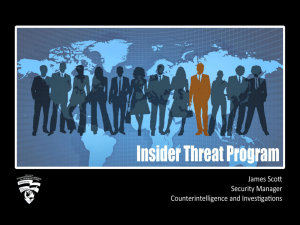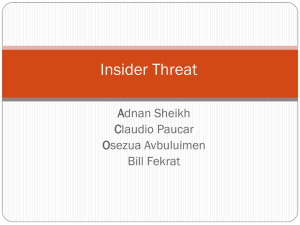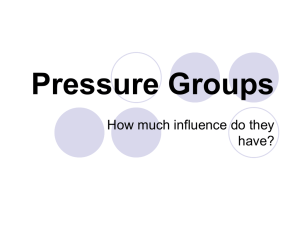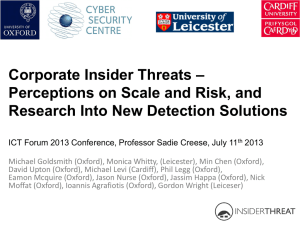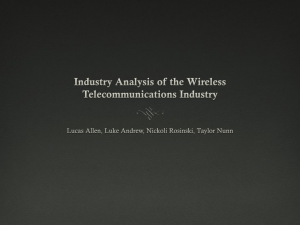Insider Threat Program March 2014
advertisement
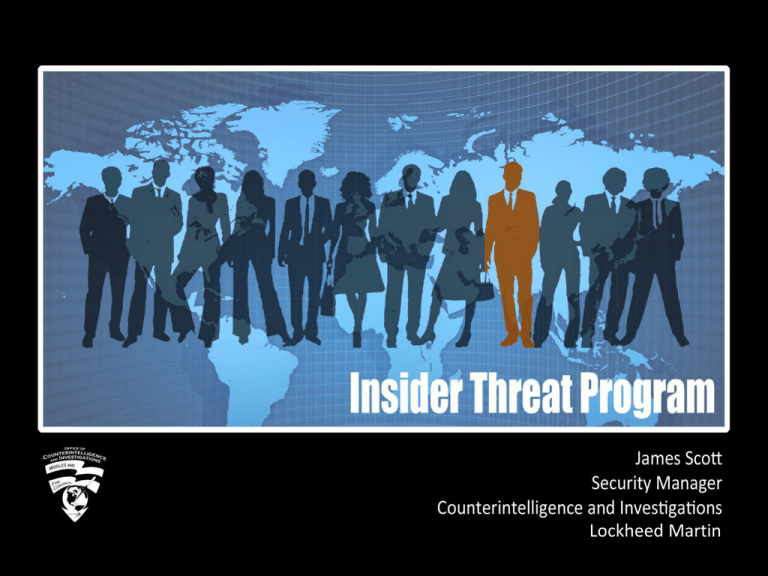
Lockheed Martin 1 Topics • Insider Case • Understanding the Insider • Building an Insider Threat Program 2 3 Pvt. Bradley Manning U.S. Army “I was actively involved in something that I was completely against” 4 Edward Snowden CIA/NSA 5 Media Coverage • Government “Spies” receive much more media coverage… …creating common misconceptions. 6 Less Media Coverage 7 Perspective Change Government Private Industry and Universities “Espionage used to be a problem for the FBI, CIA and military, but now it's a problem for corporations…” - Joel Brenner, National Counterintelligence Executive, 2008 Courtesy CI CENTRE & SPYpedia 8 Shifting Threat Landscape • External Threat – Foreign Intelligence Service (FIS) – Foreign and Domestic Industry Competitors • Landscape Has Changed – Social Media – Hiring – Penetrations – Supply Chain – Mergers & Acquisitions – Joint Ventures & University Collaboration – Students • Insider Threat – Current or former employees, contractors, and other trusted business partners with authorized access to information • Acting on behalf of FIS or in furtherance of self interests 9 Increase in Threat of Insiders • The incidence of employee financial hardships during economic downturns • The global economic crisis facing foreign nations • The ease of stealing anything stored electronically • The increasing exposure to foreign intelligence services presented by the reality of global business, joint ventures, and the growing international footprint of American firms. Courtesy CI CENTRE & SPYPEDIA 10 Steady Upward Trend • 32% of all espionage arrests since 1945 have occurred in the last 5 years (FBI) • 54% of all individuals involved with compromise of classified or proprietary information were employed in Private Sector (FBI) • Industry SCRs up 600% from 2009 (DSS) – 76% increase in SCRs evaluated “of CI interest” by DSS from 2010 to 2012 • IIRs from Industry reporting up 500% from 2009 (DSS) • USG Investigations & Operations predicated on Industry reporting up over 1000% from 2009 (DSS) Courtesy:; CI CENTRE & SPYPEDIA; CERT; DSS; www.whitehouse.gov 11 Shifting Value in Corporate Assets Composition of the S&P 500 100 80 % Value 60 40 20 0 1975 1985 Tangible Assets 1995 2005 2009 Intangible Assets “The U.S. economy has changed over the past 20 years. Intellectual capital rather than physical assets now represent the bulk of a U.S. corporation’s value. This shift has made corporate assets far more susceptible to espionage.” - “Protecting Key Assets: A Corporate Counterintelligence Guide”, The office of the National Counterintelligence Executive (ONCIX), 2013 Source: Ocean Tomo Intellectual Capital Equity, Courtesy Office of The National Counterintelligence Executive 12 Insider Threat Impact: Industry Reports ► Insider threat is not the most numerous type of threat ► 1900+ reported incidents in the last 10 years ► ~ 19% of incidents involve malicious insider threat actors ► Insider threats are the most costly and damaging ► Average cost $412K per incident ► Average victim loss: ~$15M / year ► Multiple incidents exceed $1 Billion Sources: Ponemon Data Breach Reports: ‘08, ‘09, ‘10, ’11 IDC 2008 FBI / CSI Reports: ‘06, ‘07, ’08’, ‘09, ‘10/’11 Verizon Business Data Breach Reports: ‘09, ‘10, ‘11, ’12 CSO Magazine / CERT Survey: ‘10, ‘11 Carnegie Mellon CERT 2011 IP Loss Report 13 Cisco Risk Report ‘08 Understanding the Insider Threat 14 Define the Insider • Authorized people using their trusted access to do unauthorized things • Threat actors vs. threats • Boils down to actors with some level of legitimate access, and with some level of organizational trust • Inadvertent or Malicious Insiders 15 Potential Risk Indicators • Attempts to bypass security controls • Request for clearance or higher level access without need • Unjustified work pattern • Chronic violation of organization policies • Decline in work performance • Irresponsible social media habits • Unexplained sudden affluence • Outward expression of conflicting loyalties • Unreported foreign contacts / foreign travel (when required) • Maintains access to sensitive data after termination notice • Visible disgruntlement towards employer • Use of unauthorized digital external storage devices 16 Psychosocial Indicators Disgruntlement Responds poorly to criticism Inappropriate response to and/or inability to cope with stress at work Sudden Change in Work Performance Emotional Change in Beliefs Unusual Level of Pessimism Unusual Level of Sadness Difficulty Controlling Emotions Ego Domineering Harassment Argumentative Superiority Complex Selfish Manipulative Rules Do Not Apply Poor Teamwork Irritability Threatening Retaliatory Behavior Relationship/Financial Problems Divorce Marriage Problems Stress at Home Financial Problems Inappropriate response to and/or inability to cope with stress at home Unexplained Change in Financial Status Irresponsibility Selfish 17 How and Why Sabotage (Physical or Electronic) 5% Disclosure of Sensative Information 47% Facilitation of 3rd Party Access 6% Process Corruption 42% Types of Insider Acts Outside Loyalty 14% Revenge 6% Financial Gain 46% Desire for Recognition 14% Ideology 20% Primary Motivation 1 UK Centre for the Protection of National Infrastructure (CPNI) Insider Threat Data Collection Study, Report of Main Findings, April 2013 18 NISPOM Conforming Change 2 Insider Threat Program 19 1-202. Insider Threat Program • Requirements – Program in Accordance with E.O. 13587 – Designate Insider Threat “Senior Official” – Training • Senior Official • Cleared Employee – Within first 30-days (New Employee Orientation briefing) – Annually thereafter • System to maintain training records 20 Lessons Learned • Insider threats are not hackers • Insider threat is not a technical or “cyber security” issue alone • A good insider threat program should focus on deterrence, not detection • Detection of insider threats has to use behavioral based techniques 21 When Does it Happen? • 59% of employees leaving a company admit to taking proprietary information with them (FBI) • Out of 800 adjudicated insider threat cases, an overwhelming majority of subjects took the information within last 30 days of employment (CERT; Carnegie Mellon) • 60% of cases were individuals who had worked for the organization for less than 5 years (CPNI) • Majority of acts were carried out by staff (88%); 7% were contractors and 5% temporary staff (CPNI) Courtesy www.Whitehouse.gov 22 Exploitable Weaknesses UK study of 120 private and public cases Clear link found between insider acts and an employer's exploitable weaknesses – Poor management practices – Poor use of auditing functions – Lack of protective security controls – Poor security culture – Poor pre-employment screening – Poor communication between business areas – Lack of awareness of risk at the senior level – Inadequate corporate governance 1 UK Centre for the Protection of National Infrastructure (CPNI) Insider Threat Data Collection Study, Report of Main Findings, April 2013 23 Know Your Data • What are the “crown jewels” of your organization? – Critical Programs – Critical Assets – Critical Components – What keeps your Chief Technology Officer (CTO) up at night! • What data / people would the enemy want to target? – Suppliers of Critical Components • Action: – Identify sensitive data – Rate top 5 most important systems in terms of sensitive data – Gather data about the systems/personnel – Create a Counterintelligence Support Plan (CISP)/ Insider Threat Plan – Now your supply chain! 24 Know Your Enemy • Who would be targeting your organization? • Who would they target inside your organization? • Who are the high risk individuals in your organization? – Program Managers – Field Service Reps – Fellows – SMEs – Employees Identified on web, Public Release Announcements, etc – Published, Publications, Conference Speakers, Patents Document in your CISP! 25 CI Program Key Partnerships • Organizational Leadership • Functional Leadership • Computer Intrusion Response Team / Chief Information Officer • Legal / Privacy • Human Resources • Ethics • Communications / Public Affairs • Chief Technology Officer • Intelligence and Law Enforcement Communities Document in your CISP! Courtesy www.whitehouse.gov 26 Potential CI Program Challenges • Organizational Leadership buy-in • Funding • Hiring a team of experienced CI Professionals • Organizational stovepipes • Development of key performance measures • No routine, relevant threat data from Government • No / limited access to secure DoD networks Courtesy www.whitehouse.gov 27 Selling the C-Suite • Hiring of Experienced CI Professionals (NISPOM Requirement) • Increasing Trends in Economic / Industrial Espionage • Examples of Cases: – DuPont – Shriver – Snowden • Corporate “Crown Jewels” (Intangible vs. Tangible Assets) • Cost Comparison (Investment vs. Potential Loss) – U.S. Chamber of Commerce: IP theft estimated to cost U.S. companies $200-$250 billion per year! • Program Benchmarking • Business Advantage Courtesy www.NCIX.gov 28 Business Advantage Insider Threat Detection Programs are complex, expensive and may take years to achieve tangible results… However… • The goal is survival in a hostile marketplace • If your data is secure, you can penetrate risky markets • In-depth Insider Threat Program a Business Discriminator Your enemy is your business partner! 29 Summary • Threat is real • Nation States are quite capable • New tools in the tool bag – Social Media – Hiring • Government (DoD and IC) emphasizing CI within Private Sector – CI in Contracts – Supply Chain – Insider Threat - NISPOM Conforming Change #2 • Importance of a dedicated CI program Courtesy www.whitehouse.gov 30 Contact Info James Scott Security Manager Investigations/ Counterintelligence 407-356-9396 James.o.scott@lmco.com 31 Back-up Slides 32 Government Response • Appointment of US Intellectual Property Enforcement Coordinator • Report to Congress on Foreign Economic Collection & Industrial Espionage • Executive Order 13587 • Creation of the National Insider Threat Task Force • Administration Strategy on Mitigating The Theft of Trade Secrets • Anticipated NISPOM Conforming Change #2 • Anticipated Insider Threat Language from the National Institute of Standards & Technology (NIST) • Pronouncement of April 26th, World Intellectual Property Day • CI Support to Contracts • CI Support to Global Supply Chain Operations Courtesy www.whitehouse.gov 33 FBI Pop-up Example 34


